A Promising Recycling Strategy via Processing Polypropylene/Recycled Poly(ethylene terephthalate): Reactive Extrusion Using Dual Compatibilizers
Abstract
:1. Introduction
2. Experimental Sections
2.1. Materials
2.2. Sample Preparation
2.3. Characterizations
2.3.1. Fourier Transform Infrared Spectroscopy (FTIR)
2.3.2. Scanning Electron Microscopy (SEM)
2.3.3. Rheological Characterization
2.3.4. Differential Scanning Calorimetry (DSC)
2.3.5. Thermogravimetric Analysis (TGA)
2.3.6. Mechanical Properties
3. Results and Discussion
3.1. In Situ Reactions between Components during the Mixing Process
3.2. Morphological Analysis
3.3. Rheological Behavior
3.4. Crystallization Behavior Analysis
3.5. Thermal Behaviour Analysis
3.6. Mechanical Properties and Toughening Mechanisms
4. Conclusions
- FTIR and morphological analyses demonstrated that GMA-based compatibilizers acted as a bridging agent between the PP/PP-g-MA and rPET phases by forming graft copolymers at the interface via in situ reactions during melt blending.
- The results reveal that compatibilizers with higher GMA content exhibit more extensive in situ grafting reactions, leading to improved compatibility between the blend components.
- DSC analysis of the blends with dual compatibilizers indicates that the addition of GMA-based compatibilizers alters the crystallization behavior, leading to a reduction in crystallization temperature, crystallization enthalpy, and degree of crystallinity. These observations confirm the role of the secondary compatibilizers in suppressing the crystallization process.
- Notably, for the PT/MA3/EMA3 sample, mechanical properties such as elongation at break, tensile strength, and notched Izod impact strength increased by 217%, 17.7%, and 114.3%, respectively, compared to the uncompatibilized sample. The enhanced performance can be attributed to the high GMA content and its reactions with the functional end groups of rPET and MA, which improved energy transfer. Additionally, the longer chain length and presence of flexible acrylic ester groups in the EMA compatibilizer contributed to increased mechanical properties.
- The same considerable improvement in thermal properties in terms of onset temperature for degradation is observed for the PT/MA3/EMA3 sample, with 40 °C and 33 °C increases compared to the uncompatibilized and the single compatibilized samples.
- This study highlights the potential of tailored dual compatibilizer systems to upgrade PP/rPET blends. The insights gained from this research can be used to develop more effective material designs for recycling thermodynamically incompatible plastic waste streams.
Supplementary Materials
Author Contributions
Funding
Institutional Review Board Statement
Data Availability Statement
Acknowledgments
Conflicts of Interest
References
- Barati, A.; Wang, P.; Liu, S.; Dashtimoghadam, E. Reactive Blending of Recycled Poly(Ethylene Terephthalate)/Recycled Polypropylene: Kinetics Modeling of Non-Isothermal Crystallization. ACS Omega 2023, 8, 15062–15074. [Google Scholar] [CrossRef]
- La Mantia, F.P.; Ceraulo, M.; Giacchi, G.; Mistretta, M.C.; Botta, L. Effect of a Compatibilizer on the Morphology and Properties of Polypropylene/Polyethylentherephthalate Spun Fibers. Polymers 2017, 9, 47. [Google Scholar] [CrossRef] [PubMed]
- Kong, Y.; Li, Y.; Hu, G.; Lin, J.; Pan, D.; Dong, D.; Wujick, E.; Shao, Q.; Wu, M.; Zhao, J.; et al. Preparation of Polystyrene-b-Poly(Ethylene/Propylene)-b-Polystyrene Grafted Glycidyl Methacrylate and Its Compatibility with Recycled Polypropylene/Recycled High Impact Polystyrene Blends. Polymer 2018, 145, 232–241. [Google Scholar] [CrossRef]
- Nomura, K.; Peng, X.; Kim, H.; Jin, K.; Kim, H.J.; Bratton, A.F.; Bond, C.R.; Broman, A.E.; Miller, K.M.; Ellison, C.J. Multiblock Copolymers for Recycling Polyethylene-Poly(Ethylene Terephthalate) Mixed Waste. ACS Appl. Mater. Interfaces 2020, 12, 9726–9735. [Google Scholar] [CrossRef] [PubMed]
- Ekinci, A.; Öksüz, M.; Ates, M.; Aydin, I. Thermal and Mechanical Properties of Polypropylene/Post-Consumer Poly (Ethylene Terephthalate) Blends: Bottle-to-Bottle Recycling. J. Polym. Res. 2022, 29, 433. [Google Scholar] [CrossRef]
- Zhang, Z.; Wang, C.; Mai, K. Reinforcement of Recycled PET for Mechanical Properties of Isotactic Polypropylene. Adv. Ind. Eng. Polym. Res. 2019, 2, 69–76. [Google Scholar] [CrossRef]
- Akshaya, E.M.; Palaniappan, R.; Sowmya, C.F.; Rasana, N.; Jayanarayanan, K. Properties of Blends from Polypropylene and Recycled Polyethylene Terephthalate Using a Compatibilizer. Mater. Today Proc. 2020, 24, 359–368. [Google Scholar] [CrossRef]
- Zhu, Y.; Liang, C.; Bo, Y.; Xu, S. Compatibilization of Polypropylene/Recycled Polyethylene Terephthalate Blends with Maleic Anhydride Grafted Polypropylene in the Presence of Diallyl Phthalate. J. Polym. Res. 2015, 35, 1. [Google Scholar] [CrossRef]
- Yue, X.H.; Zhang, F.S.; Wu, L.X.; Zhang, C.C.; Qian, P. Upcycling of Blending Waste Plastics as Flexible Growing Substrate with Superabsorbing Property. Chem. Eng. J. 2022, 435, 134622. [Google Scholar] [CrossRef]
- Marotta, A.; Causa, A.; Salzano de Luna, M.; Ambrogi, V.; Filippone, G. Tuning the Morphology of HDPE/PP/PET Ternary Blends by Nanoparticles: A Simple Way to Improve the Performance of Mixed Recycled Plastics. Polymers 2022, 14, 5390. [Google Scholar] [CrossRef]
- Bai, L.; Liu, Z.; Yu, C.; Ma, M.; Chen, S.; Shi, Y.; He, H.; Wang, X. Enhanced Interfacial Adhesion for Effectively Stress Transfer Inducing the Plastic Deformation of Matrix towards High-Toughness PC/PBT/EMA-GMA Blends. Polymer 2022, 261, 125403. [Google Scholar] [CrossRef]
- Wang, Y.; Mi, D.; Delva, L.; Cardon, L.; Zhang, J.; Ragaert, K. New Approach to Optimize Mechanical Properties of the Immiscible Polypropylene/Poly (Ethylene Terephthalate) Blend: Effect of Shish-Kebab and Core-Shell Structure. Polymers 2018, 10, 1094. [Google Scholar] [CrossRef] [PubMed]
- Moaref, R.; Shajari, S.; Sundararaj, U. From Waste to Value Added Products: Manufacturing High Electromagnetic Interference Shielding Composite from End-of-Life Vehicle (ELV) Waste. Polymers 2023, 16, 120. [Google Scholar] [CrossRef] [PubMed]
- Zhao, C.; Zhao, J.; Mark, L.H.; Chen, Z.; Soltani, I.; Lee, P.C.; Park, C.B. A Novel Strategy of Implementing Coupling Agents in Micro/Nano-Fibrillated Composites. Polymer 2023, 273, 125837. [Google Scholar] [CrossRef]
- Morshedi, F.; Tarashi, S.; Nazockdast, H. Effect of Multi-Walled Carbon Nanotube Localization on Toughening Mechanism and Electrical Properties of Compatibilized PP/EOC Immiscible Blend. Polym. Compos. 2023, 44, 650–662. [Google Scholar] [CrossRef]
- Rizvi, A.; Andalib, Z.K.M.; Park, C.B. Fiber-Spun Polypropylene/Polyethylene Terephthalate Microfibrillar Composites with Enhanced Tensile and Rheological Properties and Foaming Ability. Polymer 2017, 110, 139–148. [Google Scholar] [CrossRef]
- Liu, Q.; Zhang, X.X.; Jia, D.Z.; Yin, J.; Lei, J.; Xu, L.; Lin, H.; Zhong, G.J.; Li, Z.M. In Situ Nanofibrillation of Polypropylene/Polyethylene/Poly(Ethylene Terephthalate) Ternary System: A Strategy of Upgrade Recycling. Polymer 2023, 269, 125729. [Google Scholar] [CrossRef]
- Tarashi, S.; Nazockdast, H.; Javidi, Z.; Mehranpour, M. Long-Chain Branch-Induced Interfacial Interaction and Its Effect on Morphology Development in Polypropylene/Ethylene Octene Copolymer Blend. J. Mater. Sci. 2019, 54, 6742–6751. [Google Scholar] [CrossRef]
- Birch, N.P.; Liu, K.; Mun, S.C.; Ghazaryan, G.; Senger, C.T.; Ellison, C.J.; Macosko, C.W.; Peterson, T.H.; Mukhopadhyay, S.; Thurber, C.M. Accelerating the Coupling of Maleated Polyolefins with Polyesters via Tin Compounds. Macromolecules 2019, 52, 8359–8366. [Google Scholar] [CrossRef]
- Coba-Daza, S.; Otaegi, I.; Aramburu, N.; Guerrica-Echevarria, G.; Irusta, L.; González, A.; Neubauer, L.; Ramer, G.; Lendl, B.; Hubner, G.; et al. Unlocking Superior Properties in Polypropylene/Polyethylene Terephthalate (PP/PET) Blends Using an Ethylene-Butylene-Acrylate Terpolymer Reactive Compatibilizer. Polym. Test. 2024, 130, 108293. [Google Scholar] [CrossRef]
- Matias, Á.A.; Lima, M.S.; Pereira, J.; Pereira, P.; Barros, R.; Coelho, J.F.J.; Serra, A.C. Use of Recycled Polypropylene/Poly(Ethylene Terephthalate) Blends to Manufacture Water Pipes: An Industrial Scale Study. Waste Manag. 2020, 101, 250–258. [Google Scholar] [CrossRef]
- Gaduan, A.N.; Singkronart, K.; Bell, C.; Tierney, E.; Burgstaller, C.; Lee, K.Y. Mechanical Upcycling Immiscible Polyethylene Terephthalate-Polypropylene Blends with Carbon Fiber Reinforcement. ACS Appl. Polym. Mater. 2021, 2022, 3303. [Google Scholar] [CrossRef] [PubMed]
- Van Kets, K.; Delva, L.; Ragaert, K. Structural Stabilizing Effect of SEBSgMAH on a PP-PET Blend for Multiple Mechanical Recycling. Polym. Degrad. Stab. 2019, 166, 60–72. [Google Scholar] [CrossRef]
- Inuwa, I.M.; Che Abdul Razak, N.; Arjmandi, R.; Hassan, A. Effects of Halloysite Nanotubes on the Mechanical, Thermal, and Flammability Properties of PP-g-MAH Compatibilized Polyethylene Terephthalate/Polypropylene Nanocomposites. Polym. Compos. 2018, 39, E1554–E1564. [Google Scholar] [CrossRef]
- Gupta, A.; Misra, M.; Mohanty, A.K. Novel Sustainable Materials from Waste Plastics: Compatibilized Blend from Discarded Bale Wrap and Plastic Bottles. RSC Adv. 2021, 11, 8594–8605. [Google Scholar] [CrossRef]
- Meng, X.; Li, Y.; AlMasoud, N.; Wang, W.; Alomar, T.S.; Li, J.; Ye, X.; Algadi, H.; Seok, I.; Li, H.; et al. Compatibilizing and Toughening Blends of Recycled Acrylonitrile-Butadiene-Styrene/Recycled High Impact Polystyrene Blends via Styrene-Butadiene-Glycidyl Methacrylate Terpolymer. Polymer 2023, 272, 125856. [Google Scholar] [CrossRef]
- Ouyang, Y.; Mauri, M.; Pourrahimi, A.M.; Östergren, I.; Lund, A.; Gkourmpis, T.; Prieto, O.; Xu, X.; Hagstrand, P.O.; Müller, C. Recyclable Polyethylene Insulation via Reactive Compounding with a Maleic Anhydride-Grafted Polypropylene. ACS Appl. Polym. Mater. 2020, 2, 2389–2396. [Google Scholar] [CrossRef]
- Karaagac, E.; Koch, T.; Archodoulaki, V.M. The Effect of PP Contamination in Recycled High-Density Polyethylene (RPE-HD) from Post-Consumer Bottle Waste and Their Compatibilization with Olefin Block Copolymer (OBC). Waste Manag. 2021, 119, 285–294. [Google Scholar] [CrossRef]
- Azizli, M.J.; Dehaghi, F.M.; Nasrollahi, B.; Barghamadi, M.; Rezaeeparto, K.; Parham, S.; Mokhtary, M.; Ramakrishna, S.; Ghomi, E.R. Analysis and Modeling of Modified Styrene–Acrylonitrile/Carboxylated Acrylonitrile Butadiene Rubber Nanocomposites Filled with Graphene and Graphene Oxide: Interfacial Interaction and Nonlinear Elastoplastic Behavior. Polym. Eng. Sci. 2021, 61, 2894–2909. [Google Scholar] [CrossRef]
- Wu, H.; Hou, A.; Qu, J.P. Phase Morphology and Performance of Supertough PLA/EMA-GMA/ZrP Nanocomposites Prepared through Reactive Melt-Blending. ACS Omega 2019, 4, 19046–19053. [Google Scholar] [CrossRef]
- Asgari, M.; Masoomi, M. Thermal and Impact Study of PP/PET Fibre Composites Compatibilized with Glycidyl Methacrylate and Maleic Anhydride. Compos. B Eng. 2012, 43, 1164–1170. [Google Scholar] [CrossRef]
- Lin, J.H.; Lin, Z.I.; Pan, Y.J.; Huang, C.L.; Chen, C.K.; Lou, C.W. Polymer Composites Made of Multi-Walled Carbon Nanotubes and Graphene Nano-Sheets: Effects of Sandwich Structures on Their Electromagnetic Interference Shielding Effectiveness. Compos. B Eng. 2016, 89, 424–431. [Google Scholar] [CrossRef]
- Tang, X.; Liu, C.; Keum, J.; Chen, J.; Dial, B.E.; Wang, Y.; Tsai, W.Y.; Bras, W.; Saito, T.; Bowland, C.C.; et al. Upcycling of Semicrystalline Polymers by Compatibilization: Mechanism and Location of Compatibilizers. RSC Adv. 2022, 12, 10886–10894. [Google Scholar] [CrossRef] [PubMed]
- Huang, C.H.; Sun, D.X.; Wu, Y.; Lu, X.Y.; Wu, C.Q.; Qi, X.D.; Yang, J.H.; Wang, Y. Design of Super-Toughened, Heat-Resistant and Antistatic Polyethylene Terephthalate-Based Blend Composites by Constructing a Tenacious Interface. Polymer 2023, 277, 125966. [Google Scholar] [CrossRef]
- Friedrich, K.; Evstatiev, M.; Fakirov, S.; Evstatiev, O.; Ishii, M.; Harrass, M. Microfibrillar Reinforced Composites from PET/PP Blends: Processing, Morphology and Mechanical Properties. Compos. Sci. Technol. 2005, 65, 107–116. [Google Scholar] [CrossRef]
- Lanyi, F.J.; Wenzke, N.; Kaschta, J.; Schubert, D.W. On the Determination of the Enthalpy of Fusion of α-Crystalline Isotactic Polypropylene Using Differential Scanning Calorimetry, X-Ray Diffraction, and Fourier-Transform Infrared Spectroscopy: An Old Story Revisited. Adv. Eng. Mater. 2020, 22, 1900796. [Google Scholar] [CrossRef]
- ASTM D638-14; Standard Test Method for Tensile Properties of Plastics. ASTM: West Conshohocken, PA, USA, 2022.
- ASTM D256-23e1; Standard Test Methods for Determining the Izod Pendulum Impact Resistance of Plastics. ASTM: West Conshohocken, PA, USA, 2023.
- Sundararaj, U.; Macosko, C.W. Drop Breakup and Coalescence in Polymer Blends: The Effects of Concentration and Compatibilization. Macromolecules 1995, 28, 2647–2657. [Google Scholar] [CrossRef]
- Xu, J.; Eagan, J.M.; Kim, S.S.; Pan, S.; Lee, B.; Klimovica, K.; Jin, K.; Lin, T.W.; Howard, M.J.; Ellison, C.J.; et al. Compatibilization of Isotactic Polypropylene (IPP) and High-Density Polyethylene (HDPE) with IPP-PE Multiblock Copolymers. Macromolecules 2018, 51, 8585–8596. [Google Scholar] [CrossRef]
- Kuzmanović, M.; Delva, L.; Mi, D.; Martins, C.I.; Cardon, L.; Ragaert, K. Development of Crystalline Morphology and Its Relationship with Mechanical Properties of PP/PET Microfibrillar Composites Containing POE and POE-g-MA. Polymers 2018, 10, 291. [Google Scholar] [CrossRef]
- Van Kets, K.; Jacques, J.; Delva, L.; Ragaert, K. Contribution of Compatibilizer Backbone to Degradation and Retained Functionality of Multiple Extruded Polypropylene/Poly(Ethylene Terephthalate) Blends. J. Appl. Polym. Sci. 2021, 138, 50044. [Google Scholar] [CrossRef]
- Arayesh, H.; Golshan Ebrahimi, N.; Khaledi, B.; Khabazian Esfahani, M. Introducing Four Different Branch Structures in PET by Reactive Processing—A Rheological Investigation. J. Appl. Polym. Sci. 2020, 137, 49243. [Google Scholar] [CrossRef]
- Kuzmanović, M.; Delva, L.; Cardon, L.; Ragaert, K. The Effect of Injection Molding Temperature on the Morphology and Mechanical Properties of PP/PET Blends and Microfibrillar Composites. Polymers 2016, 8, 355. [Google Scholar] [CrossRef] [PubMed]
- Muzata, T.S.; Matuana, L.M.; Rabnawaz, M. Virgin-like High-Density Polyethylene from Recycled Mixed Polyolefins. ACS Appl. Polym. Mater. 2023, 5, 9489–9496. [Google Scholar] [CrossRef]
- Inuwa, I.M.; Hassan, A.; Samsudin, S.A.; Haafiz, M.K.M.; Jawaid, M. Interface Modification of Compatibilized Polyethylene Terephthalate/Polypropylene Blends: Effect of Compatibilization on Thermomechanical Properties and Thermal Stability. J. Vinyl Addit. Technol. 2017, 23, 45–54. [Google Scholar] [CrossRef]
- Zervoudakis, A.J.; Sample, C.S.; Peng, X.; Lake, D.; Hillmyer, M.A.; Ellison, C.J. Dihydroxy Polyethylene Additives for Compatibilization and Mechanical Recycling of Polyethylene Terephthalate/Polyethylene Mixed Plastic Waste. ACS Macro Lett. 2022, 11, 1396–1402. [Google Scholar] [CrossRef]
- Coba-Daza, S.; Carmeli, E.; Otaegi, I.; Aranburu, N.; Guerrica-Echevarria, G.; Kahlen, S.; Cavallo, D.; Tranchida, D.; Müller, A.J. Effect of Compatibilizer Addition on the Surface Nucleation of Dispersed Polyethylene Droplets in a Self-Nucleated Polypropylene Matrix. Polymer 2022, 263, 125511. [Google Scholar] [CrossRef]
- Liu, X.X.; Huang, Y.Z.; Huang, Z.X. Compatibilizing and Functionalizing Polypropylene/Polyethylene by in-Situ Exfoliating Hexagonal Boron Nitride at Interface. Compos. Sci. Technol. 2022, 221, 109354. [Google Scholar] [CrossRef]
- Todd, A.D.; McEneany, R.J.; Topolkaraev, V.A.; Macosko, C.W.; Hillmyer, M.A. Reactive Compatibilization of Poly(Ethylene Terephthalate) and High-Density Polyethylene Using Amino-Telechelic Polyethylene. Macromolecules 2016, 49, 8988–8994. [Google Scholar] [CrossRef]
- Klimovica, K.; Pan, S.; Lin, T.W.; Peng, X.; Ellison, C.J.; Lapointe, A.M.; Bates, F.S.; Coates, G.W. Compatibilization of IPP/HDPE Blends with PE-g-IPP Graft Copolymers. ACS Macro Lett. 2020, 9, 1161–1166. [Google Scholar] [CrossRef]
- Wolff, P.; Dickert, A.; Kretschmer, W.P.; Kempe, R. IPP/PE Multiblock Copolymers for Plastic Blend Recycling Synthesized by Coordinative Chain Transfer Polymerization. Macromolecules 2022, 55, 6435–6442. [Google Scholar] [CrossRef]


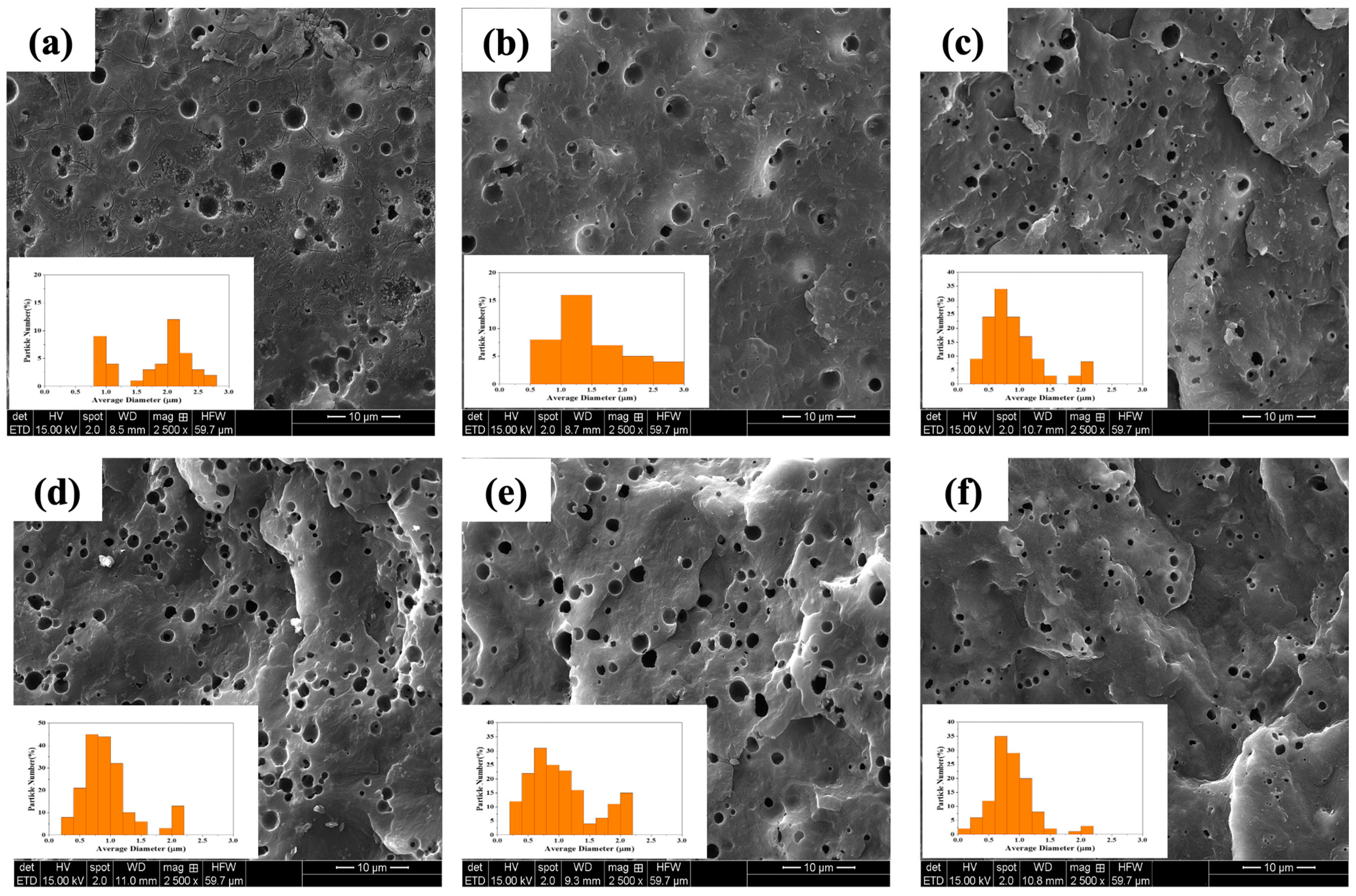
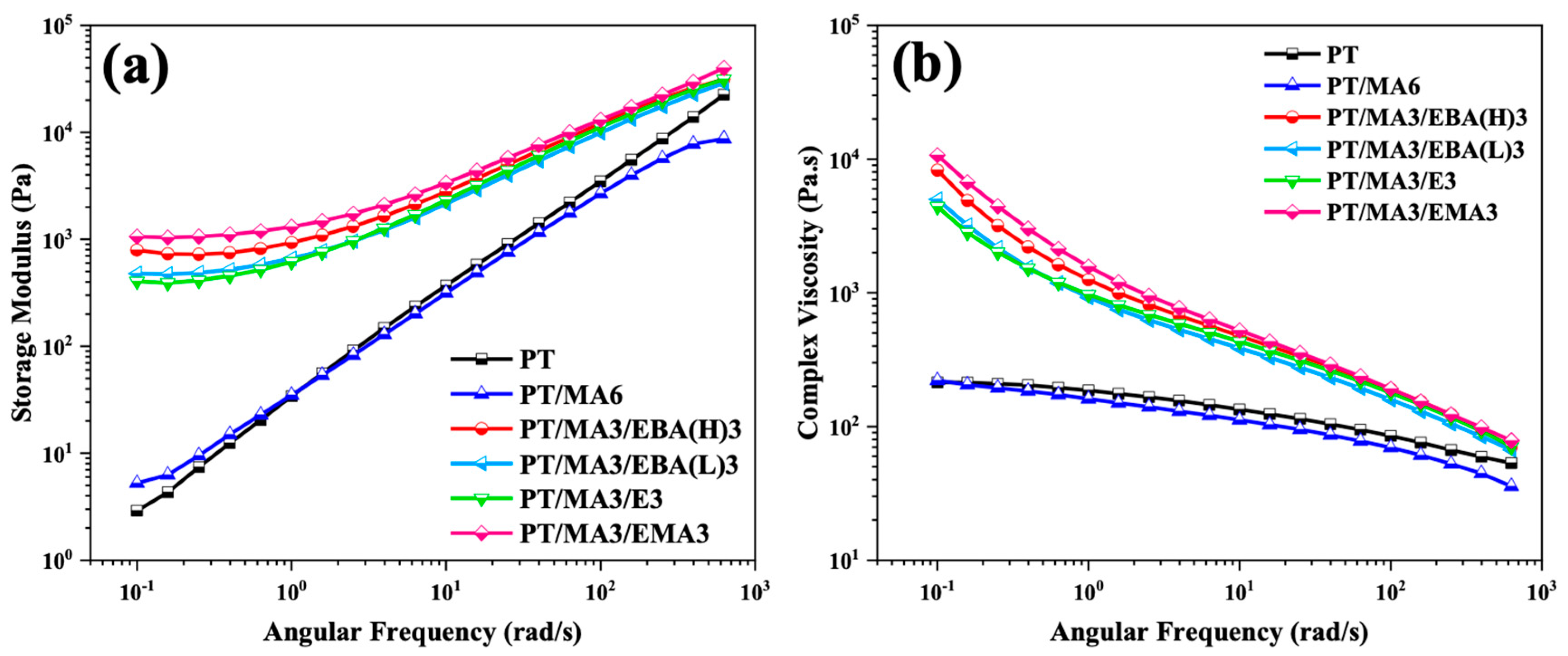
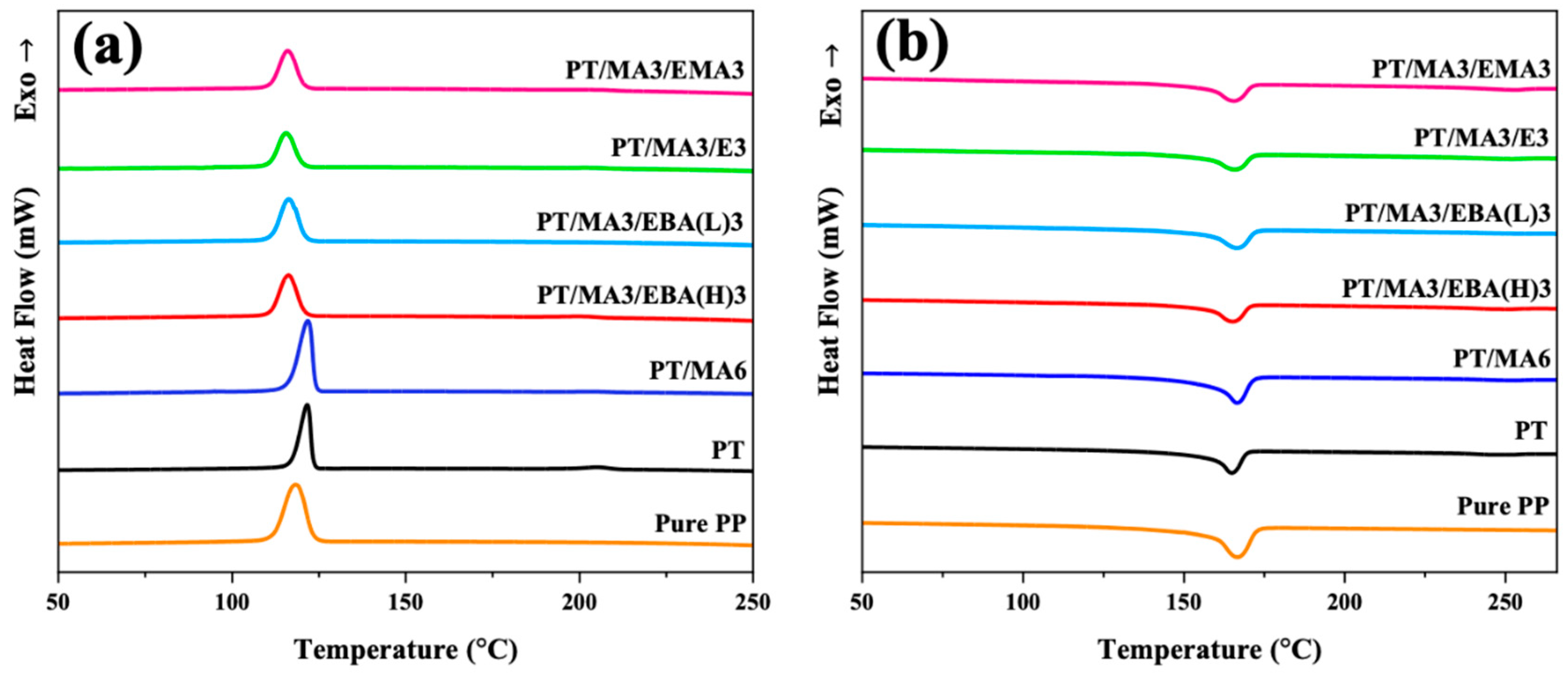
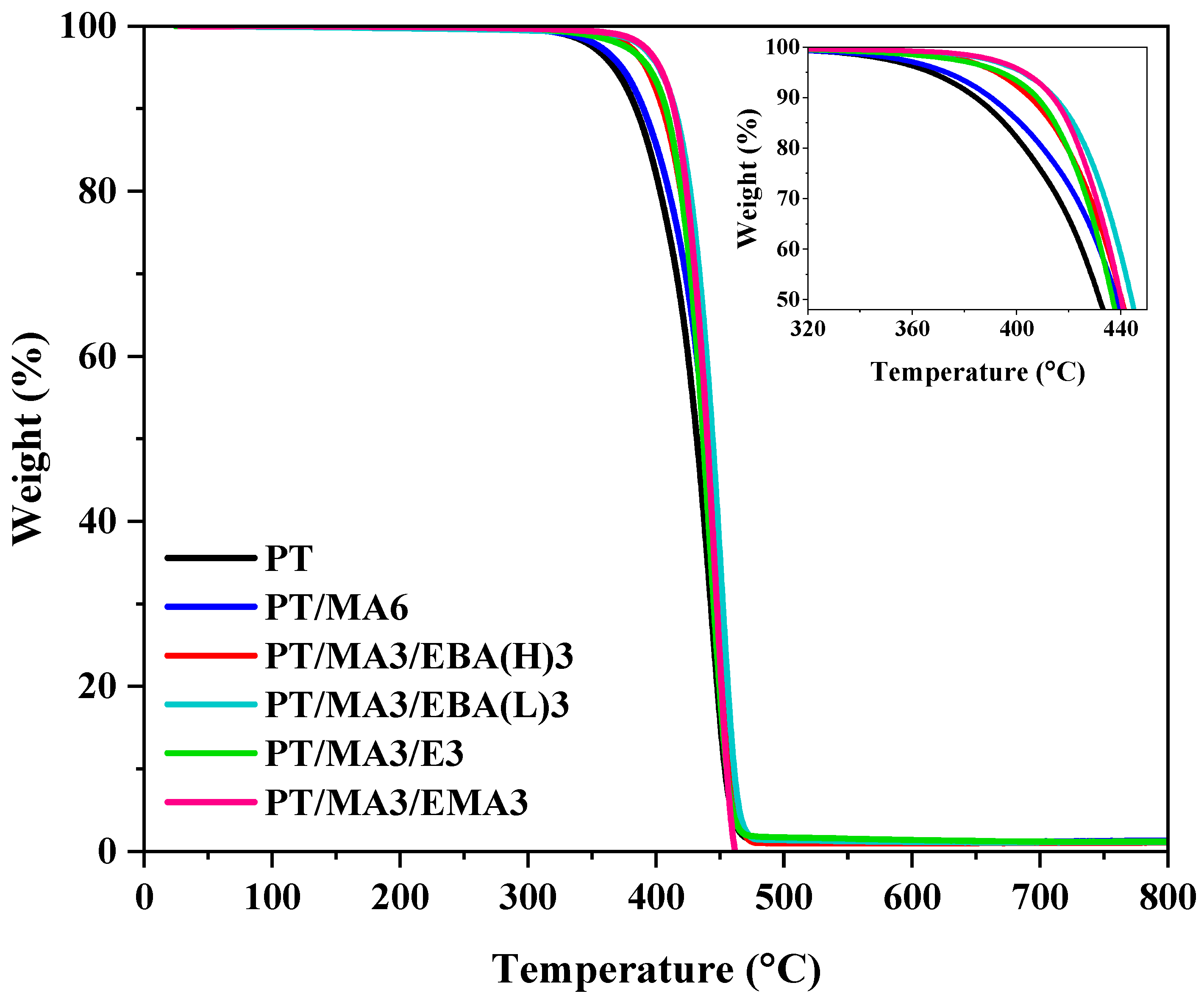
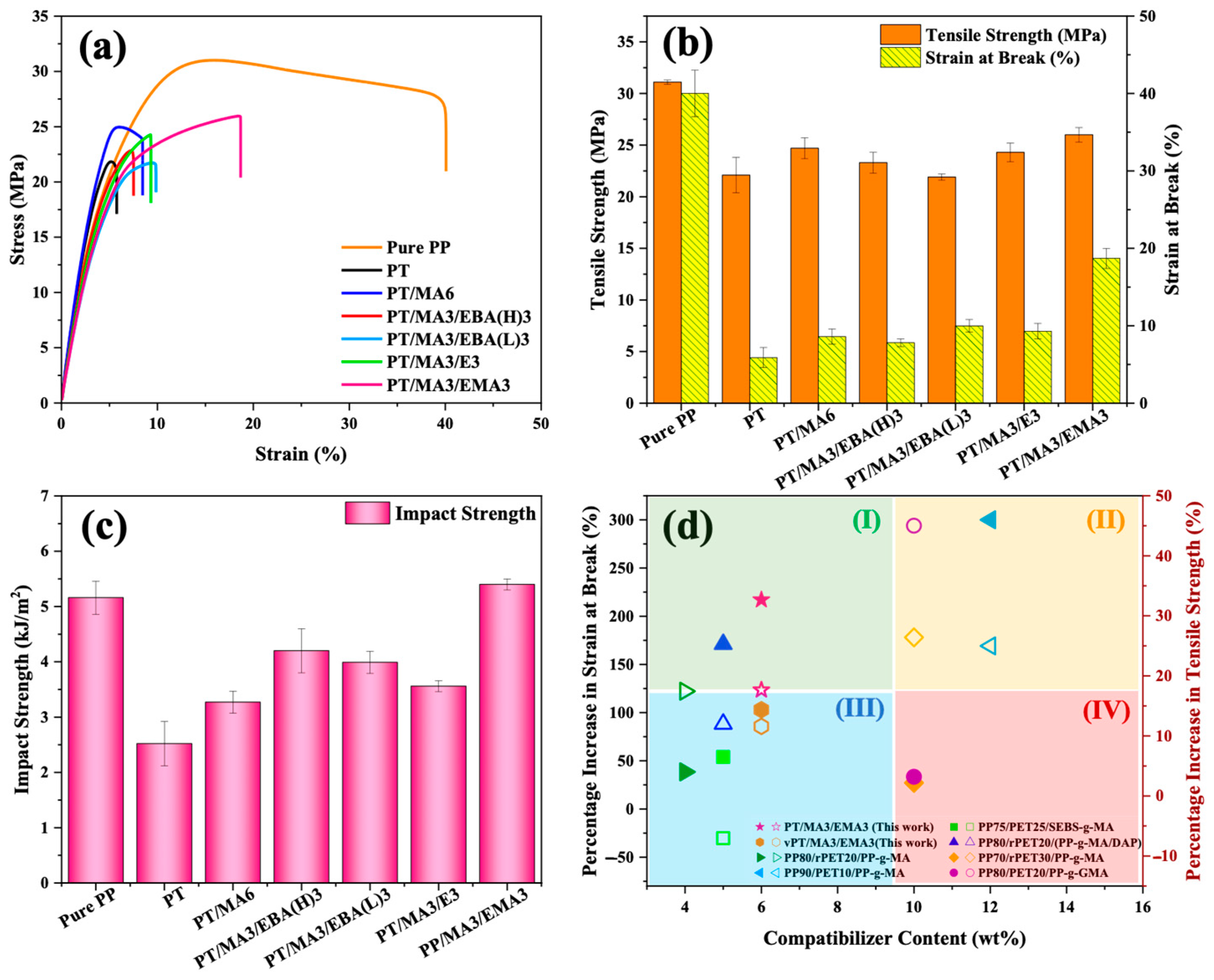
| Compatibilizer | Code | Grade | Acrylate Content (%wt) | GMA Content (%wt) | MFI (g/10 min) |
|---|---|---|---|---|---|
| Ethylene-butyl acrylate-glycidyl methacrylate terpolymer | EBA(H) | LOTADER AX8700 | 25 | 8 | 9 |
| EBA(L) | LOTADER AX8750 | 25 | 5 | 12 | |
| Ethylene-glycidyl methacrylate copolymer | E | LOTADER AX8840 | 0 | 8 | 5 |
| Ethylene-methyl acrylate glycidyl methacrylate terpolymer | EMA | LOTADER AX8900 | 24 | 8 | 6 |
| Sample Code | PP (phr) | vPET (phr) | rPET (phr) | PP-g-MA (phr) | 2nd Compatibilizer (phr) * | |||
|---|---|---|---|---|---|---|---|---|
| 1 | 2 | 3 | 4 | |||||
| Pure PP | 100 | 0 | 0 | 0 | 0 | 0 | 0 | 0 |
| vPT | 80 | 20 | 0 | 0 | 0 | 0 | 0 | 0 |
| PT | 80 | 0 | 20 | 0 | 0 | 0 | 0 | 0 |
| PT/MA6 | 80 | 0 | 20 | 6 | 0 | 0 | 0 | 0 |
| PT/MA3/EBA(H)3 | 80 | 0 | 20 | 3 | 3 | 0 | 0 | 0 |
| PT/MA3/EBA(L)3 | 80 | 0 | 20 | 3 | 0 | 3 | 0 | 0 |
| PT/MA3/E3 | 80 | 0 | 20 | 3 | 0 | 0 | 3 | 0 |
| PT/MA3/EMA3 | 80 | 0 | 20 | 3 | 0 | 0 | 0 | 3 |
| Sample | Tc (°C) | Tm (°C) | ΔHc (J/g) | ΔHm (J/g) | Xc (%) |
|---|---|---|---|---|---|
| Pure PP | 118.3 | 166.7 | 110.0 | 92.0 | 44.4 |
| PT | 121.6 | 164.9 | 78.9 | 79.0 | 47.7 |
| PT/MA6 | 121.8 | 166.6 | 91.3 | 82.6 | 49.8 |
| PT/MA3/EBA(H)3 | 116.7 | 165.2 | 73.0 | 60.9 | 36.8 |
| PT/MA3/EBA(L)3 | 116.3 | 166.7 | 87.2 | 76.6 | 46.3 |
| PT/MA3/E3 | 115.6 | 165.9 | 76.3 | 67.2 | 40.6 |
| PT/MA3/EMA3 | 115.9 | 165.6 | 75.9 | 61.5 | 37.2 |
| Sample | Tonset (°C) | T10 (°C) | T50 (°C) | Tmax (°C) |
|---|---|---|---|---|
| PT | 367 | 384 | 431 | 444 |
| PT/MA6 | 374 | 390 | 438 | 449 |
| PT/MA3/EBA-(H)3 | 390 | 405 | 440 | 444 |
| PT/MA3/EBA-(L)3 | 407 | 415 | 444 | 451 |
| PT/MA3/E3 | 403 | 408 | 437 | 440 |
| PT/MA3/EMA3 | 407 | 414 | 440 | 446 |
Disclaimer/Publisher’s Note: The statements, opinions and data contained in all publications are solely those of the individual author(s) and contributor(s) and not of MDPI and/or the editor(s). MDPI and/or the editor(s) disclaim responsibility for any injury to people or property resulting from any ideas, methods, instructions or products referred to in the content. |
© 2024 by the authors. Licensee MDPI, Basel, Switzerland. This article is an open access article distributed under the terms and conditions of the Creative Commons Attribution (CC BY) license (https://creativecommons.org/licenses/by/4.0/).
Share and Cite
Morshedi Dehaghi, F.; Aberoumand, M.; Sundararaj, U. A Promising Recycling Strategy via Processing Polypropylene/Recycled Poly(ethylene terephthalate): Reactive Extrusion Using Dual Compatibilizers. Polymers 2024, 16, 2439. https://doi.org/10.3390/polym16172439
Morshedi Dehaghi F, Aberoumand M, Sundararaj U. A Promising Recycling Strategy via Processing Polypropylene/Recycled Poly(ethylene terephthalate): Reactive Extrusion Using Dual Compatibilizers. Polymers. 2024; 16(17):2439. https://doi.org/10.3390/polym16172439
Chicago/Turabian StyleMorshedi Dehaghi, Fatemeh, Mohammad Aberoumand, and Uttandaraman Sundararaj. 2024. "A Promising Recycling Strategy via Processing Polypropylene/Recycled Poly(ethylene terephthalate): Reactive Extrusion Using Dual Compatibilizers" Polymers 16, no. 17: 2439. https://doi.org/10.3390/polym16172439





